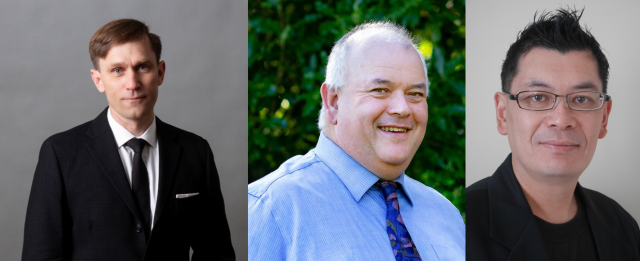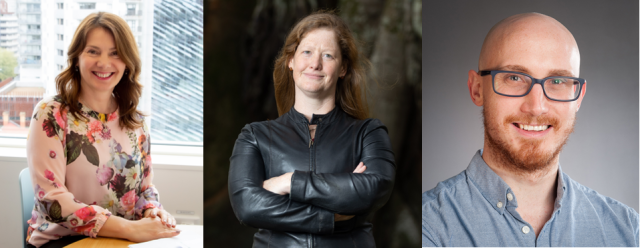Impact story: Nanoscience

At the heart of nanoscience lies a simple premise, to understand and manipulate things at the atomic scale. New Zealand has a storied history of nanoscience beginning with Lord Ernest Rutherford OM FRS FNZI and living on through research institutes like the MacDiarmid Institute for Advanced Materials and Nanotechnology, Te Whai Ao – Dodd Walls Centre, and Paihau – Robinson Research Institute.
Since its inception, the Marsden Fund has supported New Zealand’s greatest thinkers to follow their boldest ideas. In quantum physics and nanotechnology, this creativity is leading to fundamental knowledge and commercialisation. With a nod to physicist Professor Richard Feynman’s famous 1959 lecture, we’ve shown “there’s plenty of room at the bottom” for us kiwis.
A concerted focus for competitive advantage
The Marsden Fund grant is absolutely crucial in enabling us to really push on with this work.
The first Marsden Fund Committee was intent on strengthening New Zealand’s competitive position in the field of quantum physics. From the very first funding round, investment was made in groups at Otago, Victoria and Auckland Universities.
In 2004, pioneer of Nuclear Magnetic Resonance (NMR) Microscopy, the late Professor Sir Paul Callaghan GNZM FRS FRSNZ (Te Kunenga Ki Pūrehuroa - Massey University), won the prestigious Ampere Prize. The research he was recognised for had received a Marsden Fund grant in 1997 as part of the concerted quantum physics focus.
Callaghan also formed Magritek with fellow researchers in 2004. The company’s small-scale nuclear magnetic resonance and MRI imaging products are now sold all over the world. It’s a story that inspires many New Zealand researchers.
The Committee’s 1997 efforts also included a grant to the late Professor Dan Walls FRS FRSNZ and his group (Waipapa Taumata Rau - University of Auckland) to explore the possibilities of an ‘atom laser’. Finally, the biggest grant of the 1998 funding round was awarded to a major Te Whare Wānanga o Waitaha - University of Canterbury-based initiative in nanoscience and optical lithography. Led by Professor Simon Brown, and also funding Professor Richard Blaikie FRSNZ, it comprised four inter-linked projects and aimed to seed a comprehensive research effort and to provide New Zealand with a competitive edge in a fast-developing field.

L to R: The late Sir Paul Callaghan with Prime Minister John Key GNZM AC in 2010, the late Professor Dan Walls (image: Dodd-Walls Centre), Professor Simon Brown (image: UOC), Professor Richard Blaikie.
These early directions paved the way for consistent grants in quantum physics and nanoscience - they have played a pivotal role in many significant insights and discoveries. Within the wider mosaic of funding, the Marsden Fund also supported the establishment of the research centres, and the investment in people and resources that has helped create such an innovation pipeline for New Zealand nanotechnologies.
Fundamental insights and discoveries
Quantum physics research can be loosely divided into theoretical and experimental approaches, but often has elements of both. Professor Joachim Brand (Massey University) and Associate Professor Mikkel Andersen (Ōtākou Whakaihu Waka -University of Otago) have a Marsden Fund grant for their mainly theoretical research triggered by an experiment in Andersen’s lab. They explore how the chaotic motion of atoms in a gas emerges when working with very few atoms, ie by using ‘optical tweezers’ to add individual atoms together, one-by-one.
“While this research question is very much driven by curiosity”, says Brand, “it is also important foundational work”. He thinks that highly accurate quantum sensors or better hardware for quantum computers might be developed with the results of this project.
Understanding the fundamental and theoretical behaviour of atoms provides a foundation for future technology, says Andersen. He has worked in research institutes all over the world and says countries that put a stronger emphasis on theoretical physics also have bigger tech industries. “If you don’t make the investment, you don’t get the outcomes.”
Professor Blair Blakie (University of Otago) is known for his ground-breaking theoretical work showing that under certain conditions gases can form into stable droplets as liquids do. This has been confirmed experimentally by scientists in Germany and the findings published in Nature.
It’s an exciting discovery that opens the door to potential applications performing chemical reactions or making highly precise measurements of magnetic fields.
Working at a more experimental level, Professor Niels Kjærgaard (University of Otago) has built an ultra-cold atom machine which uses powerful laser beams to create clouds of potassium and rubidium atoms at temperatures of less than a millionth of a degree above absolute zero. This highly regarded work won the 2023 Hector Medal and follows the pioneering studies of our most famous scientist, Lord Ernest Rutherford.
Superconductivity is another amazing phenomenon at the nanoscale, whereby materials conduct electricity with no electrical resistance under specific conditions, like the extremely cold temperatures of liquid nitrogen, or even colder. Such cold temperatures have hampered the commercialisation of superconducting materials. In New Zealand, we are world leaders in higher temperature superconductors (HTS), thanks in part to Marsden Funding. Developments by Professors Jeff Tallon CNZM FRSNZ, Bob Buckley, and Rod Badcock FRSNZ (all Robinson Research Institute) are crucial in realising the commercial potential of HTS, although more work is needed.
Tallon and Industrial Research Limited studied HTS compounds and their use in diverse sectors—health, transport, energy, mining and minerals processing, telecommunications and information technology, as well as in research.

L to R: Professor Niels Kjaergaard, Professor Rod Badcock, and Dr Shen Chong.
Tallon’s work, frequently collaborating with Buckley, has led to companies like superconducting magnet manufacturer HTS-110 and contributed to the science behind startup company OpenStar Technology, which leverages high-temperature superconducting materials to explore nuclear fusion.
Badcock’s research is already having commercial impact and he is bringing his expertise to OpenStar. He explores HTS solutions that could enable step-change increases in the power density and efficiency of electric machines, such as high-speed trains, using superconducting motors and electric power distribution systems.
Another recent innovation is the use of organic inorganic hybrids in HTS. Dr Shen Chong (Robinson Research Institute) has spent more than a decade developing new organic-inorganic metal oxide layered hybrids with Tallon. Together with HTS-100 and other scientists, they have commercialised a system for determining the characteristics of superconducting wires.
Overall, the HTS work sets the stage for a new, widescale industry in all-electric aircraft and could revolutionise power systems, aerospace population, and clean energy.
Lighting the way: quantum optics and photons
Worldwide, the race is on to further develop ultrafast laser spectroscopy with its potential for printable plastic electronics, such as solar cells and biosensors.
Professor Justin Hodgkiss FRSNZ (Te Herenga Waka—Victoria University of Wellington) is having success on a number of fronts. His group invented ‘transient grating ultrafast fluorescence spectroscopy’ and has a detailed understanding of photocurrent generation in printable solar cells.
In 2022, Hodgkiss spun Advemto out of this research, providing advanced 2D molecular barcode readers. These enable clinical and pharmaceutical labs to identify hundreds of biomarkers simultaneously.
Hodgkiss is also known for world-first technology on how melanin protects skin from UV radiation. Eumelanin may guide the design of new optical components and sunscreens and may later be applied to a host of other biomaterials.

(L) Professor Justin Hodgkiss, and (R) Associate Professor Natalie Plank.
Professor Miro Erkintalo, Associate Professor Stuart Murdoch and Professor Stéphane Coen FRSNZ (all University of Auckland), are among those exploring quantum optics, and optical frequency combs in particular, with considerable achievement. The trio developed a novel micro laser source capable of generating new optical frequencies tunable across the mid-infrared spectrum.
While lasers are everywhere in the modern world, frequencies in the mid-infrared range are difficult to generate yet are needed for the sensitive detection of many chemicals. The group’s Marsden-funded invention is cheap, tiny and suitable for commercialisation. The ground-breaking results were published in Nature Photonics in 2019. Since then, other groups have succeeded in reproducing the results on different microresonator platforms, most importantly, in integrated photonic chip devices.
To achieve such high performance, Erkintalo, Murdoch and Coen collaborated closely with Professor Harald Schwefel’s microresonator lab at the University of Otago.
Schwefel, and others such as Associate Professor Jevon Longdell (University of Otago), are working on exciting developments in quantum devices and frequency conversion. They have created optical frequency combs of record efficiency that show potential to significantly improve the internet by reducing the power required to encode data and the information-carrying capacity of optical fibres.
Professor Eric Le Ru (Victoria University of Wellington) uses light to measure materials. He has developed a spectroscopy device that delivers accurate tests of liquids that were previously thought impossible. His company, Marama Labs, has raised investment to take its “hazy wine analysis” business and expand into pharmaceutical manufacturing and life sciences.
“Early investors were from New Zealand, then very quickly from the US and Ireland,” said Le Ru. “The wine angle was a good place to start because we had access to a lot of wineries in New Zealand, but it was never the end game. Surface-enhanced Raman spectroscopy has always promised to be quite big, but it's never really realised its promise in applications because making it work is hard. So it’s exciting to take it from the theoretical and to figure out that promise.”
Also exploring fluids, Associate Professor Natalie Plank (Victoria University of Wellington), works on biosensors to measure substances, such as blood glucose levels, with a wide range of potential agricultural, clinical, and environmental applications.
Plank is interested in developing energy efficient devices out of nanomaterials, including carbon nanotubes and graphene. Her research couples biological receptors, such as aptamers, or insect odorant receptors, onto nanomaterials to make ultrasensitive and selective sensors.
She says the whole point of working on the nanoscale is that certain materials behave in radically different ways than they do when they’re bigger.
“They can become more sensitive and have different kinds of interactions—they might change the way they conduct electricity or interact with light. For us as scientists, it’s about exploiting those new properties that you don’t get at larger scales.”
Plank is also Deputy Director for Commercialisation and Industry Engagement at The MacDiarmid Institute. She says the potential for growth in the nanotechnology industry is huge.
“In 2020, the global nanotech market was worth about US$1.6 billion, and by 2030 it’s predicted to be worth over US$30 billion.”
Creative solutions
Scientists are looking to nanoscience to tackle some of the world’s most challenging problems. At the nanoscale, the exposed surface of a material increases, often leading to new physical properties, such as changes in melting point, magnetic permeability, chemical reactivity, or electrical conductivity, for example.
One such is Professor Nicola Gaston FRSNZ (University of Auckland), who focuses on the underlying structure of materials and her work gives us fundamental insights into how atoms behave in alloys and at the surface. Such insights are essential for any future commercialisation in nanocatalysis, where surface atoms carry out catalytic reactions.
Professor Jadranka Travas-Sejdic FRSNZ incorporated Spot Check Technologies Ltd with Emeritus Professor David Williams FRSNZ (both University of Auckland) for detecting the DNA signatures of infectious and chronic diseases. Her group is also developing novel polymeric materials that are stretchable enough for medical use but crystalline enough for electronic performance, but this, she says, “remains a challenge”.
Professor Wei Gao ONZM FRSNZ (University of Auckland) has made significant contributions in thin films and coatings, light alloys and corrosion. He and his group discovered a simple method to produce “black titania”, which can collect energy by absorbing UV from sun light, dramatically improving the efficiency of solar energy.
Taking things a step closer to commercialisation, Dr Nathaniel Davis (Victoria University of Wellington and Te Whai Ao — Dodd-Walls Centre for Photonic and Quantum Technologies) has developed a solar panel that can effectively cut photons in half allowing for improved efficiencies. Having filed a patent authored by himself and a PhD student arising directly from the initial Marsden Fast-Start grant, Davis is now being mentored by commercialisation experts across New Zealand readying for launch.

L to R: Professor Jadranka Travas-Sejdic, Professor Nicola Gaston, and Dr Nathaniel Davis.
Other quantum chemistry research dedicated to finding cheap, clean and sustainable energy sources is being undertaken by Associate Professor Anna Garden (University of Otago), for example via hydrogen evolution reaction. Her group is also looking to refine the Haber-Bosch process by which ammonia forms to improve efficiency and output for more environmentally friendly production.
In research looking for a similar outcome, Dr Mathew Anker (Victoria University of Wellington) has described the synthesis of a highly reactive lanthanide(II) hydride complex. If ammonia can be produced under these conditions, it will transform the worldwide economy of fertilisers.
The founder of New Zealand’s first ever nanotechnology company, Professor Simon Brown (University of Canterbury) works on neuromorphic chips, and has an ongoing interest in the wider ethical, social, environmental and health impacts of nanotechnology.
“This has the potential for a huge impact on the world, by providing a low-cost computer chip that uses self-assembled nanocomponents to build brain-like structures that naturally support new approaches for solving highly complex tasks, including pattern and image recognition,” explains Brown.
“Currently 8 percent of the world’s power consumption is used to run computers and these chips should help reduce power consumption,” he says. “The Marsden Fund grant is absolutely crucial in enabling us to really push on with this work and show that we can do useful computing with our novel chips.”
New Zealand’s creativity in manipulating the atom is giving us an edge in developing nanotechnologies and leading to unexpected ways of solving global problems. Consistent investment in fundamental research is generating start-ups and commercialisations. The promise of a major break-through seems tantalisingly close, whether this comes from high-temperature superconductors, new energy sources, or solar panels.
The Marsden Fund has been there to help support and enable our research community to dream big about little things. Thirty years of fundamental science at the atomic level has already led to remarkable discoveries – what will the next three decades bring?
